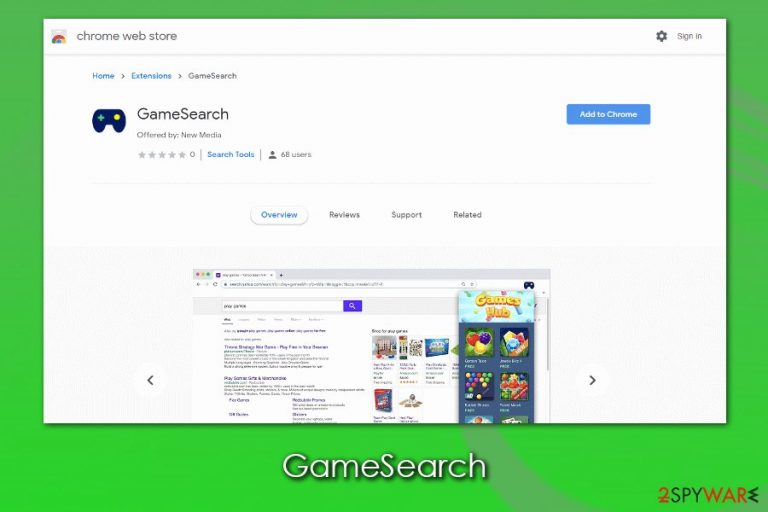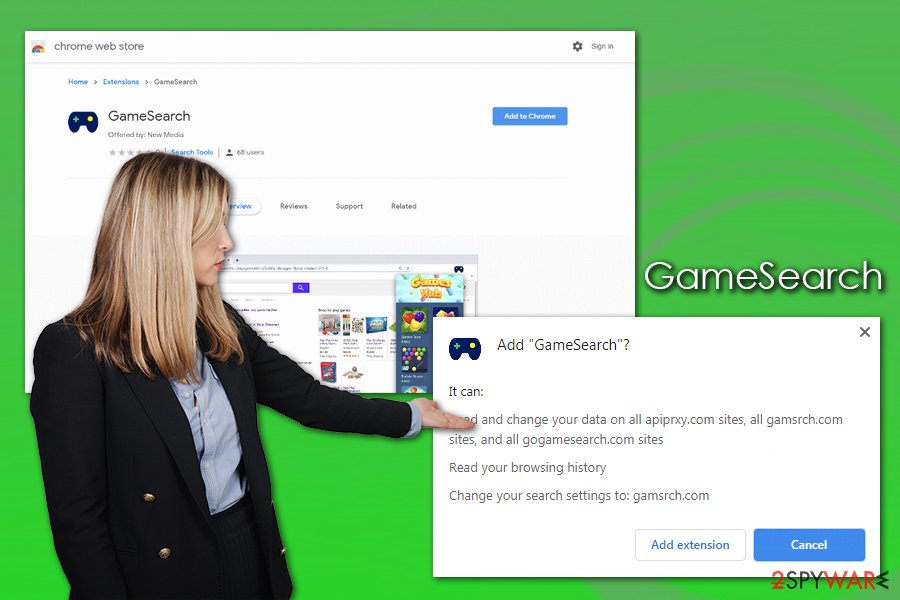GameSearch (Free Instructions) - Removal Guide
GameSearch Removal Guide
What is GameSearch?
GameSearch is a potentially unwanted application that attaches itself to the web browser to hijack users' searches

GameSearch is a browser extension that offers users various links to free online games and other popular services like Gmail. However, the application is also known for its browser-hijacking[1] traits and is often detected as PUP.Optional.SearchManager.BITSRST by trusted security tools. Besides, this potentially unwanted program (also called PUP) is often spread via shady techniques such as software bundle packages or can be installed unintentionally when tricked by a fake notification on a random website.
Once installed, GameSearch hijacker will change the settings of Google Chrome, Mozilla Firefox, MS Edge, or another web browser: the homepage and the new tab address are swapped to gamsrch.com, and a customized search engine is added. This ensures that users' searches will be redirected via a particular way – the results will be shown via the Yahoo provider and also include multiple sponsored links. Additionally, GameSearch would also spy on users' online activities by using cookies and other tracking technologies.
| Name | GameSearch |
| Type | Potentially unwanted program, browser hijacker |
| Detection | PUP.Optional.SearchManager.BITSRST |
| Infiltration | While the browser extension can be downloaded from official sources, users usually end up installing it unintentionally after downloading freeware from third-party websites. Also, users might be deliberately tricked into downloading the PUP via fake update prompts or similar deceptive ads |
| Symptoms |
|
| Dangers | Users might be misguided into installing other unwanted applications that might, in some cases, be dangerous; risk of suffering from financial losses due to scams and fraudulent websites |
| Termination | You can eliminate the hijacker by following our manual guide below or scanning the device with a reputable anti-malware software |
| Optimization | You can fix any type of registry or other damage done to the computer due to infections with FortectIntego |
To begin the analysis of the GameSearch virus, we should first explore its infiltration techniques, which are often deceptive. In most cases, users would not install apps that would redirect their searchers and show them ads, so the developers come up with distribution tactics that would ensure a large number of the installs.
Software bundles and deceptive ads are perfect choices for browser hijackers and similar potentially unwanted programs. Bundled software is often placed on various third-party websites that use freeware as the main monetization method, and deceptive ads can trick users into installing GameSearch voluntarily, even though they do now know much about its functionality in the first place.
Once installed on the system, GameSearch would alter web browser settings in order to deliver users sponsored search results. Most browser hijackers do not use their engines to deliver search results but rather employ established sources such as Yahoo or Bing (they use affiliate program). However, the results are not genuine, as the links placed at the top are ads – essentially, websites that paid to be there. This way, users' web browsing experience can be changed drastically, and some might not even realize that of that happening.
The only way to stop these activities is to remove GameSearch hijacker from the computer, as the settings changed by the PUP will remain unchanged, and users will have to face inaccurate search results, suffer from an increased amount of advertisements, and end up being tracked in the background.

Speaking of data tracking, all browser hijackers, including GameSearch, use technologies like cookies or web beacons to collect information about users' online experiences and habits. In most cases, the following information is tracked:
- IP address;
- Location (if enabled via the mobile device);
- Internet Service Provider (ISP);
- Websites visited;
- Duration of the visit;
- Ads and links clicked;
- Cookies, etc.
To stop the data tracking and other revert browser changes, you should perform a full GameSearch removal from the web browser. To do that, simply right-click on the extension and select uninstall. However, it is also important to check for other PUPs or malware, so you should perform a full system scan with powerful anti-virus software. If something is detected, eliminate unwanted apps and then fix virus damage with tools like FortectIntego.
PUP.Optional.SearchManager.BITSRST detection
PUP.Optional.SearchManager is a detection name for a number of potentially unwanted applications that belong to the search hijacker category. These unwanted apps typically come as a browser extension/add-on for Chromium or Chrome web browsers. In most cases, users can see the icon of the extension at the top-right corner of the browser window.
PUP.Optional.SearchManager.BITSRST can be downloaded from the official web store, users can also encounter advertisements on various gaming websites. These ads typically advertise the hijacker as a useful tool with particular functionality, for example:
Play hundreds of FREE online games
Step 1: Click “Continue”
Step 2: Click “Ad to Chrome”
Step 3: Enjoy!
Such an ad might sure sound promising, as users might be tempted to play games seemingly for free. However, a reputable anti-malware solution is installed on the system, the extension will be detected as PUP.Optional.SearchManager.BITSRST and the installation will be stopped, as it is a search hijacker in disguise.

Prevent installation of potentially unwanted programs
Potentially unwanted applications such as browser hijackers can be extremely deceptive, as users might be tricked with attractive slogans or cleverly presented ads. In most cases, people are unaware that the browser extension or standalone application is a PUP, and install it due to its functionality. However, users can soon notice an increased number of ads across all web browsers, system slowdowns, browser redirects, and other issues that might be caused by an unwanted program.
In most cases, browser hijackers are relatively harmless, although they do harvest unnecessary amounts of information for marketing purposes and display ads that might be disruptive and prevent users from finding relevant information online. Therefore, it is best to avoid unwanted applications by being attentive online, mainly when searching for new apps to install. It is easy to do, especially if precautionary measures provided by experts[2] are followed.
Most PUPs are stored on less secure third-party websites that focus on freeware distribution. For this reason, you can reduce the risk of being infected by a great margin if you would pick official sources for your downloads. Nonetheless, even Google allows some browser hijackers on its web store, so being vigilant is important.
Before installing an app you know nothing about, you should read its reviews online – forum posts, blogs, and other information that can easily make you decide whether the program is secure. Once you are sure that the app is safe, you can proceed with the download, although keep in mind that optional components can be included within the installer. Thus, never rush through the installation steps, watch out for pre-ticked boxes, and always opt for Advanced settings instead of choosing Recommended ones.
Get rid of GameSearch browser hijacker quickly
GameSearch removal should not be that difficult, as already mentioned above. All you have to do is to right-click the extension on the web browser or visit chrome://extensions/ to get rid of it.
However, since browser hijackers often perform various changes within the web browser, the unwanted ads and redirects can still occur, even after you eliminate GameSearch virus from your Chrome browser.
Therefore, you can employ reputable anti-malware software which could remove GameSearch related settings and other data. Besides, scanning the device with a powerful security program would also allow you to check your device for such threats like trojans,[3] spyware, worms, viruses, and other invisible malicious software.
You may remove virus damage with a help of FortectIntego. SpyHunter 5Combo Cleaner and Malwarebytes are recommended to detect potentially unwanted programs and viruses with all their files and registry entries that are related to them.
Getting rid of GameSearch. Follow these steps
Uninstall from Windows
To get rid of potentially unwanted applications that could be installed along GameSearch on Windows, follow these steps:
Instructions for Windows 10/8 machines:
- Enter Control Panel into Windows search box and hit Enter or click on the search result.
- Under Programs, select Uninstall a program.

- From the list, find the entry of the suspicious program.
- Right-click on the application and select Uninstall.
- If User Account Control shows up, click Yes.
- Wait till uninstallation process is complete and click OK.

If you are Windows 7/XP user, proceed with the following instructions:
- Click on Windows Start > Control Panel located on the right pane (if you are Windows XP user, click on Add/Remove Programs).
- In Control Panel, select Programs > Uninstall a program.

- Pick the unwanted application by clicking on it once.
- At the top, click Uninstall/Change.
- In the confirmation prompt, pick Yes.
- Click OK once the removal process is finished.
Delete from macOS
Users should perform the following actions if they want to eliminate adware and browser hijackers from their macOS computers:
Remove items from Applications folder:
- From the menu bar, select Go > Applications.
- In the Applications folder, look for all related entries.
- Click on the app and drag it to Trash (or right-click and pick Move to Trash)

To fully remove an unwanted app, you need to access Application Support, LaunchAgents, and LaunchDaemons folders and delete relevant files:
- Select Go > Go to Folder.
- Enter /Library/Application Support and click Go or press Enter.
- In the Application Support folder, look for any dubious entries and then delete them.
- Now enter /Library/LaunchAgents and /Library/LaunchDaemons folders the same way and terminate all the related .plist files.

Remove from Microsoft Edge
Delete unwanted extensions from MS Edge:
- Select Menu (three horizontal dots at the top-right of the browser window) and pick Extensions.
- From the list, pick the extension and click on the Gear icon.
- Click on Uninstall at the bottom.

Clear cookies and other browser data:
- Click on the Menu (three horizontal dots at the top-right of the browser window) and select Privacy & security.
- Under Clear browsing data, pick Choose what to clear.
- Select everything (apart from passwords, although you might want to include Media licenses as well, if applicable) and click on Clear.

Restore new tab and homepage settings:
- Click the menu icon and choose Settings.
- Then find On startup section.
- Click Disable if you found any suspicious domain.
Reset MS Edge if the above steps did not work:
- Press on Ctrl + Shift + Esc to open Task Manager.
- Click on More details arrow at the bottom of the window.
- Select Details tab.
- Now scroll down and locate every entry with Microsoft Edge name in it. Right-click on each of them and select End Task to stop MS Edge from running.

If this solution failed to help you, you need to use an advanced Edge reset method. Note that you need to backup your data before proceeding.
- Find the following folder on your computer: C:\\Users\\%username%\\AppData\\Local\\Packages\\Microsoft.MicrosoftEdge_8wekyb3d8bbwe.
- Press Ctrl + A on your keyboard to select all folders.
- Right-click on them and pick Delete

- Now right-click on the Start button and pick Windows PowerShell (Admin).
- When the new window opens, copy and paste the following command, and then press Enter:
Get-AppXPackage -AllUsers -Name Microsoft.MicrosoftEdge | Foreach {Add-AppxPackage -DisableDevelopmentMode -Register “$($_.InstallLocation)\\AppXManifest.xml” -Verbose

Instructions for Chromium-based Edge
Delete extensions from MS Edge (Chromium):
- Open Edge and click select Settings > Extensions.
- Delete unwanted extensions by clicking Remove.

Clear cache and site data:
- Click on Menu and go to Settings.
- Select Privacy, search and services.
- Under Clear browsing data, pick Choose what to clear.
- Under Time range, pick All time.
- Select Clear now.

Reset Chromium-based MS Edge:
- Click on Menu and select Settings.
- On the left side, pick Reset settings.
- Select Restore settings to their default values.
- Confirm with Reset.

Remove from Mozilla Firefox (FF)
Remove dangerous extensions:
- Open Mozilla Firefox browser and click on the Menu (three horizontal lines at the top-right of the window).
- Select Add-ons.
- In here, select unwanted plugin and click Remove.

Reset the homepage:
- Click three horizontal lines at the top right corner to open the menu.
- Choose Options.
- Under Home options, enter your preferred site that will open every time you newly open the Mozilla Firefox.
Clear cookies and site data:
- Click Menu and pick Settings.
- Go to Privacy & Security section.
- Scroll down to locate Cookies and Site Data.
- Click on Clear Data…
- Select Cookies and Site Data, as well as Cached Web Content and press Clear.

Reset Mozilla Firefox
If clearing the browser as explained above did not help, reset Mozilla Firefox:
- Open Mozilla Firefox browser and click the Menu.
- Go to Help and then choose Troubleshooting Information.

- Under Give Firefox a tune up section, click on Refresh Firefox…
- Once the pop-up shows up, confirm the action by pressing on Refresh Firefox.

Remove from Google Chrome
In case intrusive ads remain after PUP elimination, reset Google Chrome as explained below:
Delete malicious extensions from Google Chrome:
- Open Google Chrome, click on the Menu (three vertical dots at the top-right corner) and select More tools > Extensions.
- In the newly opened window, you will see all the installed extensions. Uninstall all the suspicious plugins that might be related to the unwanted program by clicking Remove.

Clear cache and web data from Chrome:
- Click on Menu and pick Settings.
- Under Privacy and security, select Clear browsing data.
- Select Browsing history, Cookies and other site data, as well as Cached images and files.
- Click Clear data.

Change your homepage:
- Click menu and choose Settings.
- Look for a suspicious site in the On startup section.
- Click on Open a specific or set of pages and click on three dots to find the Remove option.
Reset Google Chrome:
If the previous methods did not help you, reset Google Chrome to eliminate all the unwanted components:
- Click on Menu and select Settings.
- In the Settings, scroll down and click Advanced.
- Scroll down and locate Reset and clean up section.
- Now click Restore settings to their original defaults.
- Confirm with Reset settings.

Delete from Safari
Remove unwanted extensions from Safari:
- Click Safari > Preferences…
- In the new window, pick Extensions.
- Select the unwanted extension and select Uninstall.

Clear cookies and other website data from Safari:
- Click Safari > Clear History…
- From the drop-down menu under Clear, pick all history.
- Confirm with Clear History.

Reset Safari if the above-mentioned steps did not help you:
- Click Safari > Preferences…
- Go to Advanced tab.
- Tick the Show Develop menu in menu bar.
- From the menu bar, click Develop, and then select Empty Caches.

After uninstalling this potentially unwanted program (PUP) and fixing each of your web browsers, we recommend you to scan your PC system with a reputable anti-spyware. This will help you to get rid of GameSearch registry traces and will also identify related parasites or possible malware infections on your computer. For that you can use our top-rated malware remover: FortectIntego, SpyHunter 5Combo Cleaner or Malwarebytes.
How to prevent from getting browser hijacker
Choose a proper web browser and improve your safety with a VPN tool
Online spying has got momentum in recent years and people are getting more and more interested in how to protect their privacy online. One of the basic means to add a layer of security – choose the most private and secure web browser. Although web browsers can't grant full privacy protection and security, some of them are much better at sandboxing, HTTPS upgrading, active content blocking, tracking blocking, phishing protection, and similar privacy-oriented features. However, if you want true anonymity, we suggest you employ a powerful Private Internet Access VPN – it can encrypt all the traffic that comes and goes out of your computer, preventing tracking completely.
Lost your files? Use data recovery software
While some files located on any computer are replaceable or useless, others can be extremely valuable. Family photos, work documents, school projects – these are types of files that we don't want to lose. Unfortunately, there are many ways how unexpected data loss can occur: power cuts, Blue Screen of Death errors, hardware failures, crypto-malware attack, or even accidental deletion.
To ensure that all the files remain intact, you should prepare regular data backups. You can choose cloud-based or physical copies you could restore from later in case of a disaster. If your backups were lost as well or you never bothered to prepare any, Data Recovery Pro can be your only hope to retrieve your invaluable files.
- ^ Browser hijacking. Wikipedia. The free encyclopedia.
- ^ Lesvirus. Lesvirus. Security advice and malware news.
- ^ Josh Fruhlinger. What is a Trojan? How this tricky malware works. CSO Online. Security news, features and analysis about prevention.
